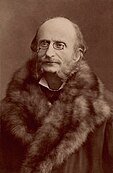Wikipedia:Today's Featured Article

Each day, a summary (roughly 975 characters long) of one of Wikipedia's featured articles (FAs) appears at the top of the Main Page as Today's Featured Article (TFA). The Main Page is viewed about 4.7 million times daily.
TFAs are scheduled by the TFA coordinators: Wehwalt, Dank and Gog the Mild. WP:TFAA displays the current month, with easy navigation to other months. If you notice an error in an upcoming TFA summary, please feel free to fix it yourself; if the mistake is in today's or tomorrow's summary, please leave a message at WP:ERRORS so an administrator can fix it. Articles can be nominated for TFA at the TFA requests page, and articles with a date connection within the next year can be suggested at the TFA pending page. Feel free to bring questions and comments to the TFA talk page, and you can ping all the TFA coordinators by adding "{{@TFA}}" in a signed comment on any talk page.
Featured article candidates (FAC)
Today's featured article (TFA):
- This month's queue
- About Today's featured article
- Recent TFAs and statistics
- Current TFA requests
- Potential TFA requests
- TFA oddities
- Most viewed TFAs
- Featured articles yet to appear as TFA
- Script to track TFA recent changes
Featured article tools:
From today's featured article
Jacques Offenbach (1819–1880) was a German-born French composer, cellist and impresario. He is remembered for his nearly 100 operettas of the 1850s to the 1870s, and his uncompleted opera The Tales of Hoffmann. Beginning as a cellist and conductor, Offenbach first wrote small-scale one-act pieces, limited by theatrical licensing laws. These eased by 1858 when he premiered his first full-length operetta, Orphée aux enfers (Orpheus in the Underworld). La belle Hélène (1864) and other successes followed. The risqué humour (often about sexual intrigue) and gentle satire in these pieces, together with Offenbach's facility for melody, made them internationally known, and he was a powerful influence on later operetta and musical theatre composers. His best-known works were continually revived during the 20th century, and many of his operettas continue to be staged in the 21st century. The Tales of Hoffmann remains part of the standard opera repertory. (Full article...)
From tomorrow's featured article
The Hanford Engineer Works (HEW) was a nuclear production complex in Benton County in the US state of Washington, established in early 1943 as part of the Manhattan Project during World War II. Plutonium manufactured at the HEW was used in the atomic bomb detonated in the Trinity test on 16 July 1945, and the Fat Man bomb used in the bombing of Nagasaki on 9 August 1945. DuPont was the prime contractor for its design, construction and operation. The land acquisition was one of the largest in US history. The construction workforce reached a peak of nearly 45,000 in June 1944. B Reactor, the world's first full-scale plutonium production nuclear reactor, went critical in September 1944, followed by D and F Reactors in December 1944 and February 1945, respectively. The HEW suffered an outage on 10 March 1945 due to a Japanese balloon bomb. The total cost of the HEW up to December 1946 was more than $348 million (equivalent to $4.1 billion in 2023). (Full article...)
From the day after tomorrow's featured article
Cora Agnes Benneson (1851–1919) was an American attorney, lecturer, and writer. She graduated from the University of Michigan, earning a Bachelor of Arts in 1878, a Bachelor of Laws in 1880, and a Master of Arts in 1883, and was licensed to practice law in Illinois and Michigan. From 1883 to 1885, she traveled the world to learn about legal cultures and how they affected women. When she returned to the United States, she undertook a nationwide lecture tour to speak about her travels and observations. In 1886 Benneson briefly worked as an editor of West Publishing's law reports before taking up a history fellowship at Bryn Mawr College under then-professor Woodrow Wilson. In 1888 she moved to Boston, where she continued to write and lecture. She was licensed in Massachusetts in 1894 and opened a law practice. She was made a fellow of the American Association for the Advancement of Science in 1899 and elected secretary of its Social and Economic Science Section in 1900. (Full article...)


